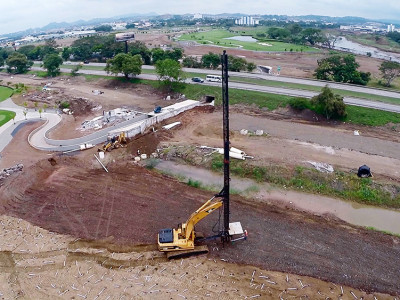Wickdrains Installation
General Overview
The wickdrains are installed in soft soil to shorten the distance the water must travel. Applying a layer of temporary load on the embankment or fill the vesting period can be reduced. Also a part of the secondary settlement is eliminated.
The purpose of installing vertical and horizontal drains is to save time and resources by providing a reduction in the period of construction of a project and also to avoid differential settlement construction post. By shortening the drainage path in soft soils such as clay and silt, just it takes months instead of years for the water to dissipate and prepare the ground to support new loads.
How Wickdrains Works?
The core
The WICKDRAIN core is a strong component, extruded structural resistant 100% polypropylene specifically designed for vertical drainage systems. A total of 38 longitudinal grooves distributed on both sides of the core discharge passages provided for the water flowing to the surface. The core is dimensionally stable when wet, has good resistance to puncture and collapse, and will not shrink or rot.
The material
WICKDRAIN filter material uses a strong, resilient, permeable nonwoven filter 100% polypropylene, specifically designed for drainage. Their continuous filaments are preferably arranged in the directions of length and width of the sheet and are thermally bonded. WICKDRAIN filter fabric is resistant to mold, putrefaction, insects and chemicals normally found in underground drainage system. It is dimensionally stable, dry or wet, has a good resistance and drip holes and will not shrink, enlarge or crumbles.
The WICKDRAIN fabric has a unique structure that enhances its function as a filter cloth. It has a large number of openings with different sizes through its structure instead of fixed size openings and woven fabrics. Their webs together create a sinuous path similar to that of an aggregate well rated filter instead of a single output, output straight to soil particles. Because of its unique structure, the filter cloth having both high permeability and the ability to restrict movement of soil particles most, while permitting a very fine silt flow into and out of the drain. The initial removal of fine silt land is beneficial because it allows the larger particles to form a network of highly permeable soil against the fabric. The ground network restricts even greater movement of fine soil particles and helps develop a graduated filter floor. This filter effectively stops ground floor pipes and prevents other fine particles from entering into the drain. The filter cloth, being more permeable than the filter natural soil and ground, does not restrict the flow of water into the drain.
Typical Uses
Construction of embankment
The vertical drains should be used to accelerate the settlement of compacted fill with retaining walls in embankments of roads, rail, runway, road bridges or fillings which should be put into operation promptly after construction is completed. The pre-filled settlements in retaining walls can greatly reduce maintenance costs in the long term, this would result in long periods of settlement during the life of the project.
Consolidation under water
Vertical drains may be used to accelerate the settling of the ground under the water level. The differential pressure created by the reload is as effective underwater and on land. This technique can be used in the preparation of tunnel sections to place on the bed of a river, for example.
Foundation tank and material storage areas
Due to high loads of units, liquid storage tanks are subject to the settlement of soft ground. Vertical drains used in conjunction with a horizontal drainage can provide a rapid consolidation of the ground before construction. Storage sites for solid materials – charcoal, mineral paper – can also benefit from vertical drainage before use.
Fill areas
Fillers are often located behind walls or cofferdams sheet stack for use in docks or industrial sites. The vertical drain is an effective method to accelerate the settlement making the site available for use in the shortest possible time.
Projects
Geotechnical teams America Inc. of the US WICK to install drainage at the site of Cleveland Cliffs at Point Lisas for Bechtel International client. This is the first time that Wick drains are installed in Trinidad and Tobago.
Biwater sewage treatment in Port of Spain.
Santa María and Country Club (Llano bonito)
Costa Sur (Centro Comercial en Juan Díaz)
Treatment plant wastewater in Llano Bonito (Trevi Galante)

